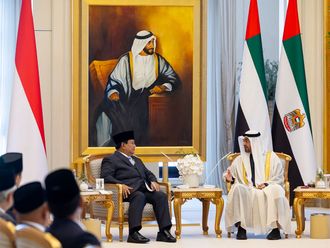
Dubai: At least 60 countries, including the United States, have pledged to cut cooling-related emissions by 2050 during the UAE COP28 climate conference.
The Global Cooling Pledge is one of nine non-negotiated declarations, pledges, and charters constituting key outcomes for the COP28 Presidential Action Agenda.
It calls for countries to reduce by 2050 their cooling-related emissions by at least 68 per cent compared to 2022 levels and increase the global average efficiency of new air conditioners by 50 per cent.
Emissions from refrigerants and the energy used in cooling account for about 7 per cent of climate-warming emissions, and energy demand for cooling could triple by 2050.
The emission targets draw on the modelling from the UNEP Cool Coalition Report Global Cooling Watch: Keeping it Chill: How to meet cooling demands while cutting emissions. The report outlines sustainable cooling measures in three areas: passive cooling, higher-energy efficiency standards, and a faster phase-down of climate-warming refrigerants.
“The cooling sector must grow to protect everyone from rising temperatures, maintain food quality and safety, keep vaccines stable and economies productive,” said Inger Andersen, UNEP Executive Director. “But this growth must not come at the cost of the energy transition and more intense climate impacts,” she said.
Cooling measures
The report’s recommendations could reduce the projected 2050 emissions from business-as-usual cooling by around 3.8 billion tons of CO2e, said UN officials.
It would allow an additional 3.5 billion people to benefit from refrigerators, air conditioners, or passive cooling by 2050, reduce electricity bills for end users by $1 trillion in 2050, and by $17 trillion cumulatively between 2022 and 2050.
It could also reduce peak power requirements by between 1.5 and 2 terawatts (TW) – almost double the EU’s total generation capacity today and avoid power generation investments from US$4 to US$5 trillion.
Adding in rapid grid decarbonization would bring the total emission cuts up to 96 per cent. G20 countries represent 73 per cent of the 2050 emission reduction potential.
As of 2022, while more than 80 per cent of countries had at least one regulatory instrument in place in these areas, implementation still needs to be improved, and an integrated approach needs to be included. Only 30 per cent of countries have regulations that enable action on all three fronts.
Passive cooling measures
Passive cooling measures – such as insulation, natural shading, ventilation and reflective surfaces – can also reduce cooling loads. These can be provided, in part, by the development and enforcement of building energy codes that incorporate passive cooling and urban design.
Such strategies can curb the growth in demand for cooling capacity in 2050 by 24 per cent, result in capital cost savings in avoided new cooling equipment of up to $3 trillion, and reduce emissions by 1.3 billion tons of CO2e.
However, finance is critical. The total life-cycle cost savings of $22 trillion ($17 trillion in power costs savings and $5 trillion in power generation investments) will make the sustainable cooling transition affordable. The report recommends that existing business models need to be scaled to use these savings to reduce upfront costs and make the transition affordable for all.
39 countries endorse Hydrogen Declaration of Intent
The COP28 Presidency also announced on Tuesday that 39 countries have endorsed the Hydrogen Declaration of Intent to pursue mutual recognition of hydrogen certification schemes.
Government ministers and CEOs of leading businesses discussed accelerating the commercialization of hydrogen projects to help keep the 1.5C goal within reach on Tuesday at the climate conference.
The discussions on the hydrogen event took place at a high-level roundtable on Tuesday. The idea of the mutual recognition of certification schemes for renewable and low-carbon hydrogen and derivates was initially developed as part of the German G7 Presidency primarily to ensure reliability and trust in trading.
The declaration's signatories include Germany, Canada, the US, Australia, Namibia, South Africa, India, and Brazil.








